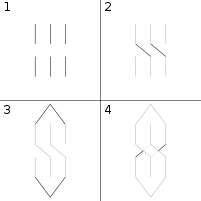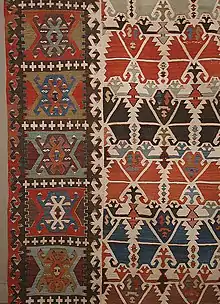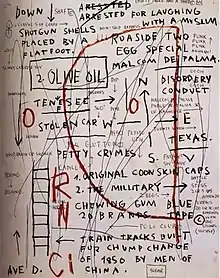Cool S
The "Cool S", also known as the "Stussy S", "Super S", "Superman S", "Pointy S", "Graffiti S",[1] and many other names, is a graffiti sign in popular culture that is typically doodled on children's notebooks or graffitied on walls. The exact origin of the "Cool S" is unknown,[1] but it may have originated from geometry textbooks[2][3] and has appeared around the early 1970s as a part of graffiti culture.[4][5] Contrary to popular belief, the symbol has no ties to either the U.S. clothing brand Stüssy or to the character Superman, though Stüssy did conduct an interview in 2010 with Jon Naar, a pioneer graffiti photographer with many works including this S, dating back to the 1970s.[3]


Shape
The "Cool S" consists of 14 line segments, forming a stylized, pointed S-shape. It has also been compared to the infinity symbol.[6] The "tails" (pointy ends) of the S appear to link underneath so that it loops around on itself in the same way as the infinity symbol does.[7] The "Cool S" has no reflection symmetry, but has 2-fold rotational symmetry. As illustrated, a common way to draw the shape begins with two sets of three parallel, vertical lines, one above the other.
History

The origin of the "Cool S" is unclear.[8] A similar S was derived from the symbols of an ancient Dacian solar cult. It was called “Carligul Ciobanului”, meaning “Shepherd’s Hook” and represented bringing back something that was lost.[9] In Latvia, the symbol was called Zalktis and represented a serpent goddess.[10] The ouroboros, which dates back to ancient Egypt and was used as a symbol of gnosticism and alchemy, was sometimes drawn with a loop to resemble the cool S.
During the Middle Ages, a strikingly close symbol became a kilim motif. Possibly related to the aforementioned Dacian symbol or the ouroboros, it was called the çengel and was supposed to destroy the evil eye.[11] The çengel was drawn with three pairs of dots or vertical lines connected much like the Cool S, but the bottom left and top right ones connected sideways, not diagonally. This is a possible explanation for the symbol’s appearance on an Anatolian rug in The Ambassadors by Hans Holbein the Younger in 1533. However, in that painting the S may also be denoting “God Almighty”.[12] A similar-looking S also appears in the 1890 book Mechanical Graphics.[2]

In the 1970’s, photographer Howard Gribble took many photos of Los Angeles, many of which feature the number 8 in a similar style to the Cool S. In one of them, a very faded Cool S can be seen graffitied on a pavement. As the photo was taken in 1973, the S itself could date back to the 1960’s, making it the earliest photographic evidence of the symbol. [3] Also in 1973, Jon Naar’s famous images of graffiti in New York featured the symbol many times, here identical to its modern form. Jean-Michel Basquiat’s artworks occasionally had the symbol hidden somewhere, and in the one titled “Olive Oil” from 1982 it is labelled as the “classic S of graff”.[13]

The name "Superman S" comes from a belief that it was a symbol for Superman, whose costume features a stylized "S" in a diamond shape, but that shape is quite different. Although frequently referred to as the "Stüssy S", Emmy Coats (who has worked alongside Shawn Stussy since 1985) has stated that it was never a symbol of the Californian surf company.[14]
Swedish Youtuber David Wångstedt, better known online as LEMMiNO, studied the topic for 5 years and attempted to find the origin of the S, but he concluded that the 1890 book Mechanical Graphics which was written by professor Frederick Newton Willson could most likely be the origin. Frederick taught geometry at Princeton University in New Jersey, where he could have shown students how to draw the S.[2][3]
References
- "how to make one graffiti S". DrawingNow DrawingNow. Retrieved May 14, 2018.
- Shepherd, Rebecca (August 14, 2019). "This Guy Spent Five Years Researching The Origins Of The 'Universal S'". LADBible. Retrieved April 30, 2020.
- https://www.youtube.com/watch?v=RQdxHi4_Pvc
- Mailer, Norman (2009). The Faith of Graffiti. It Books. ISBN 978-0061961700.
- "Interview_Gribble1". web.archive.org. 2019-08-20. Retrieved 2020-07-28.
- Lindwasser, Anna. "Here's The Story Behind That Cool 'S' Thing You Used To Draw In Class". Ranker. Retrieved August 11, 2019.
- "Local Investigates: The Mysterious S Symbol". NYU Local. February 12, 2014. Retrieved January 29, 2017.
- Neelon, Caleb (November 23, 2010). "Solve the Mystery of the Pointy S". Print Magazine. Retrieved January 29, 2017.
- https://unaltfeldejurnal.wordpress.com/2012/06/20/simboluri-arhaice-romanesti-iii/. Missing or empty
|title=(help) - https://ztzks.wordpress.com/zalksa-zime/. Missing or empty
|title=(help) - https://www.kilim.com/kilim-wiki/kilim-motifs/hook. Missing or empty
|title=(help) - https://www.theanneboleynfiles.com/holbeins-the-ambassadors-a-renaissance-puzzle-part-two-symbols/. Missing or empty
|title=(help) - Hoffman, Fred (2017). The Art of Jean-Michel Basquiat. New York: Enrico Navarra Gallery. p. 211. ISBN 978-2-911596-53-7.
The double 'S' markings on the center piece resemble other marks and gestures found in Basquiat's paintings from this time [...] While it became less and less a part of Basquiat's art production, there are continued references to graffiti style in his paintings and works on paper, such as the 'S' symbol.
- Morgans, Julian (July 23, 2016). "That 'S' Thing Everyone Drew in School, What Is It?". Vice. Retrieved March 21, 2019.
No, this is not an original Stussy Logo [...] I personally get asked this a lot, but people have been drawing this S long before Stussy was established. People have just assumed it was Stussy and it's sort of spread from there. It's actually quite amusing.